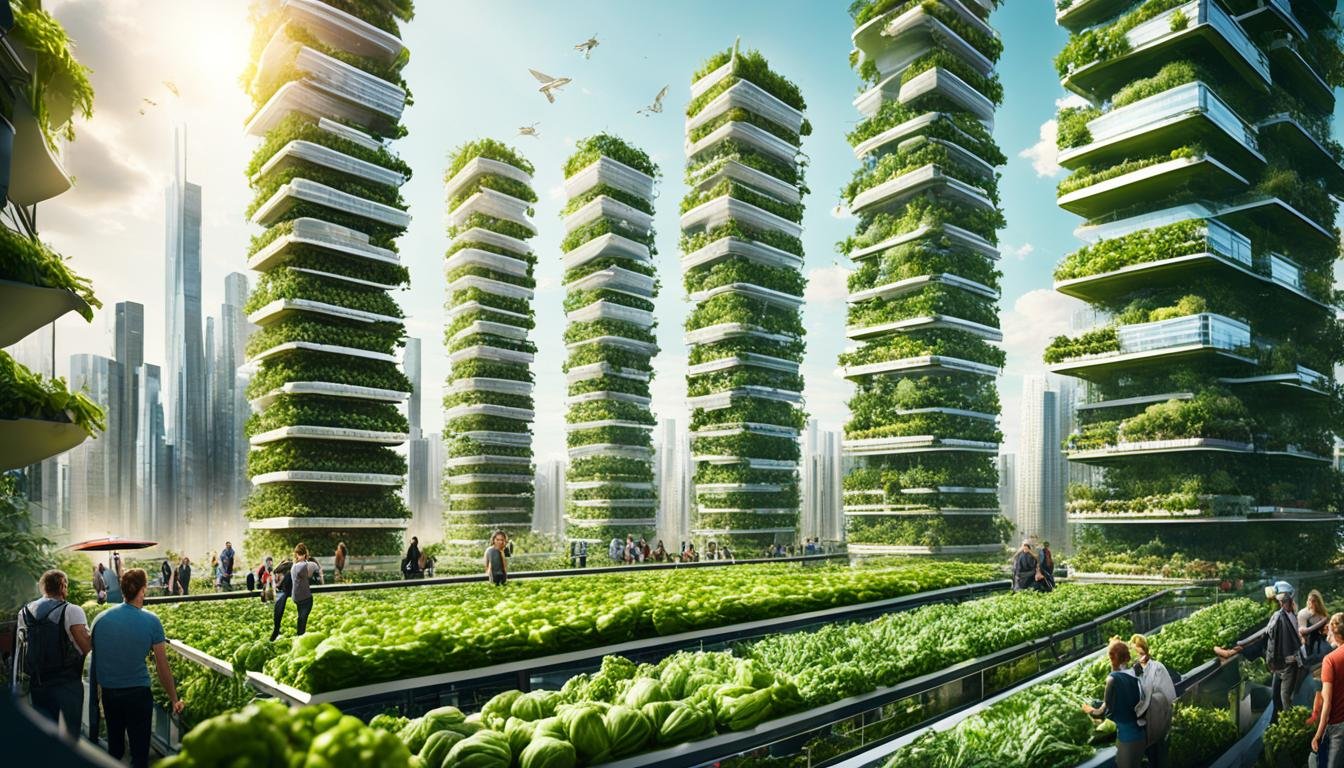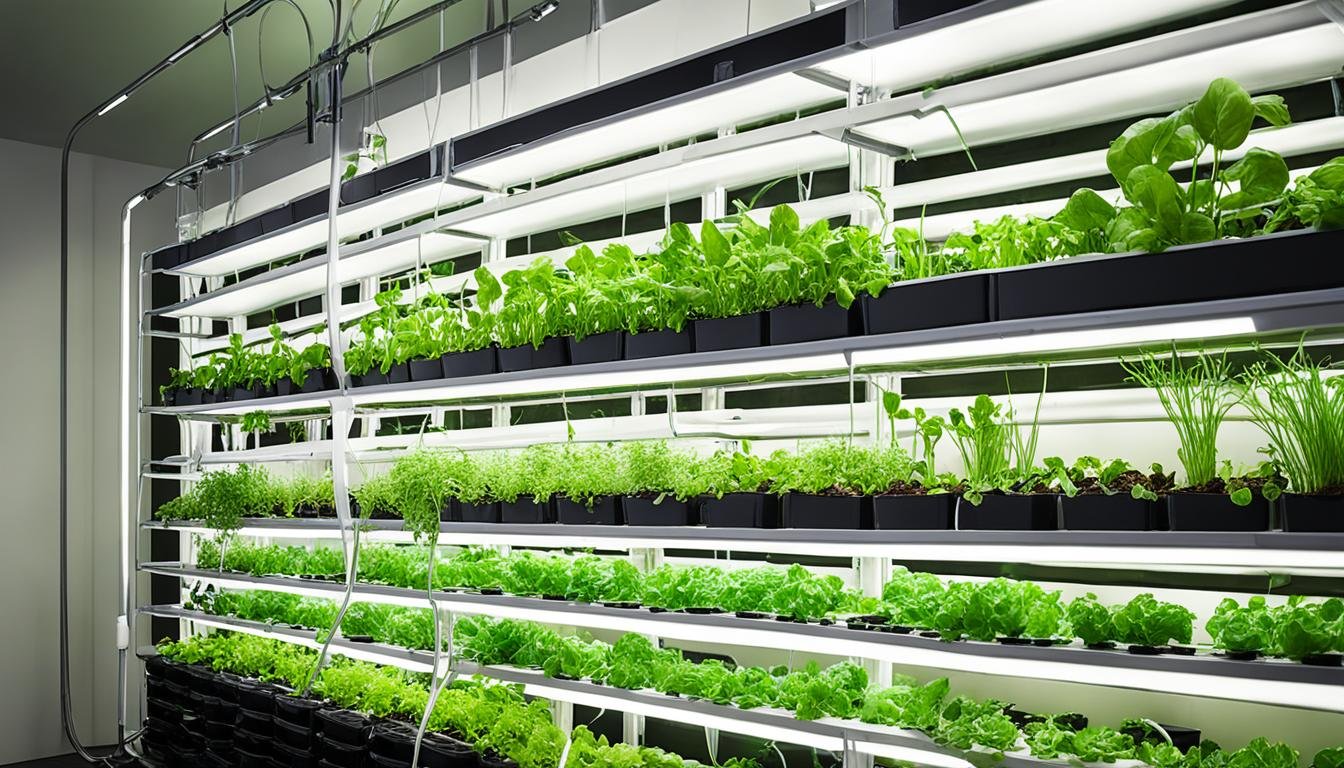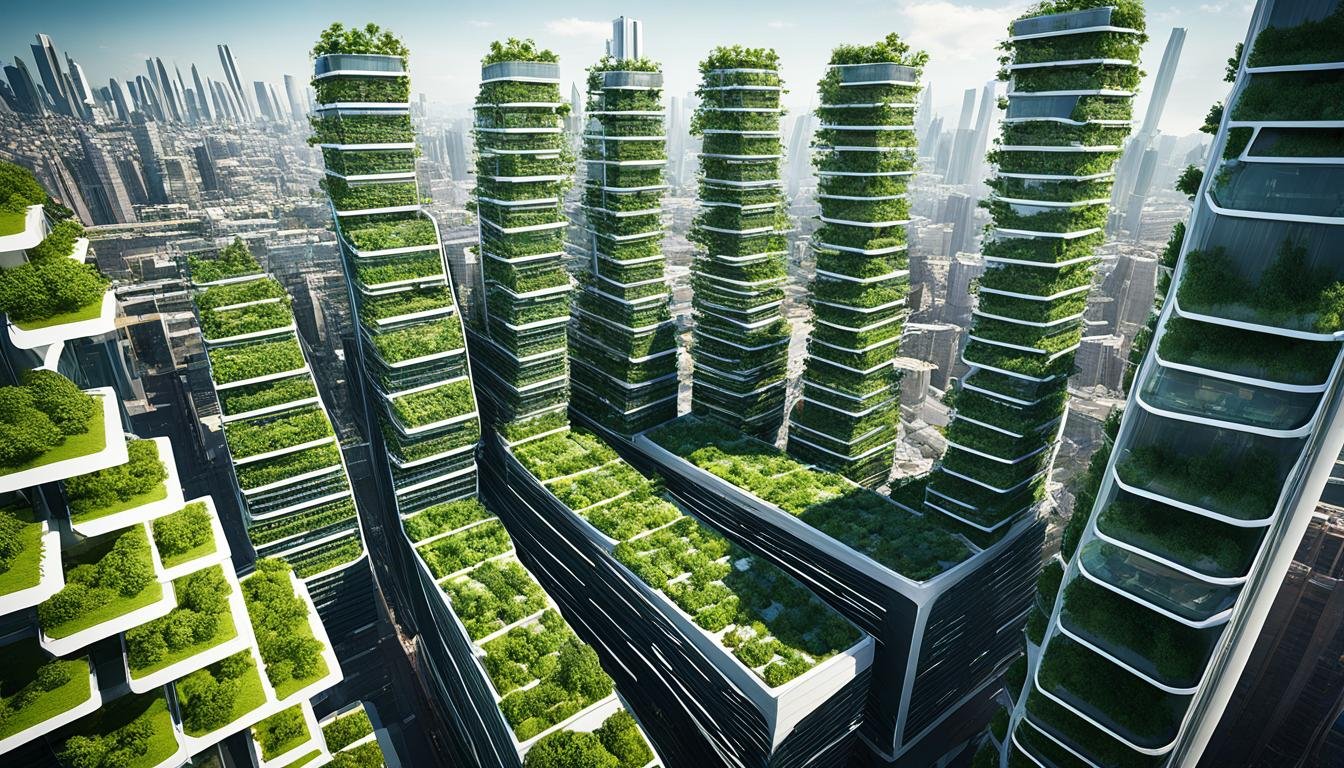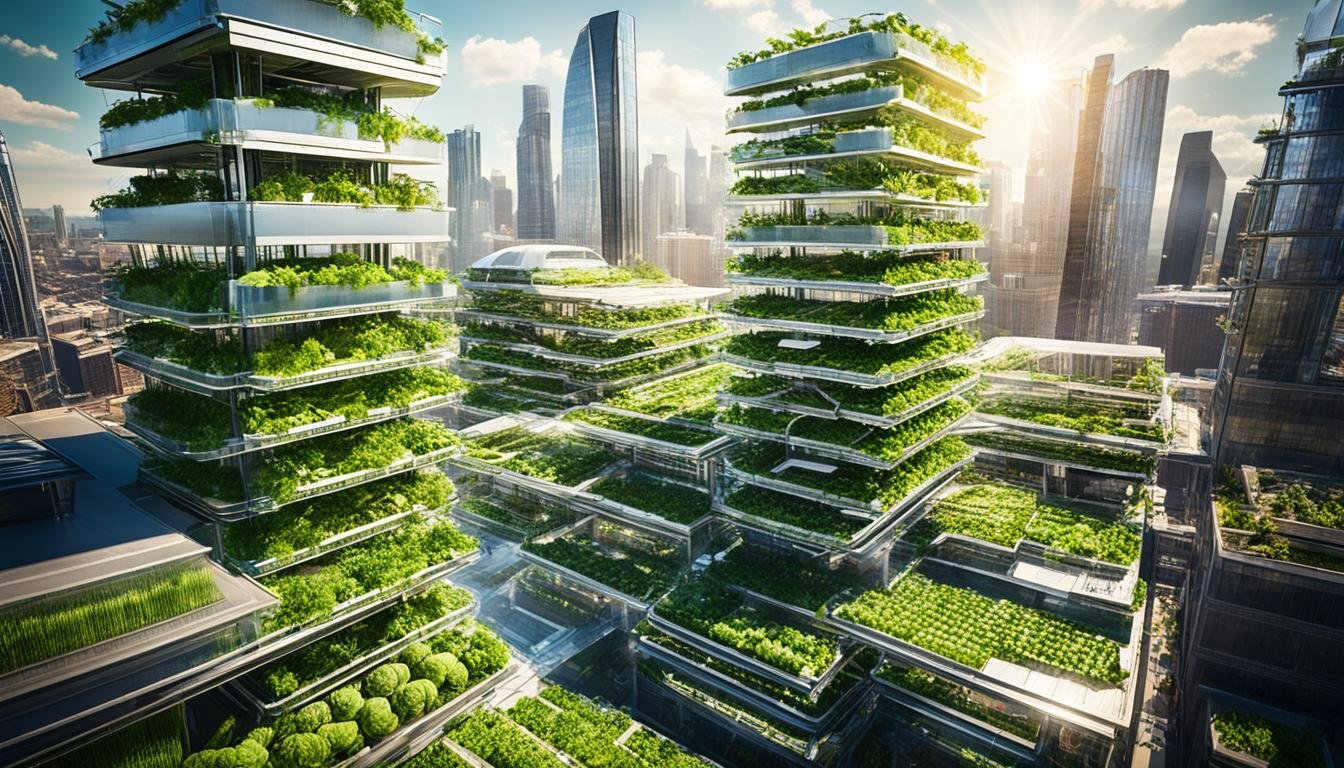Vertical farming is a new way to grow food in cities. It helps tackle food security by growing crops in tall, stacked layers. This method is key for making food sustainably in crowded cities.
It turns food deserts into fertile grounds. These are places where people struggle to find affordable, healthy food. Vertical farming uses small spaces efficiently, making it easier for people to get nutritious meals.
It’s also good for the planet. Vertical farms use less water and land and don’t rely as much on chemicals. This boosts natural ways to keep crops safe from pests.
Plus, it cuts down on polluting gases made from shipping food long distances. Vertical farms use smart lights and water systems. These technologies help save resources while feeding urban areas.
Introduction to Vertical Farming and Urban Food Security
With more people living in cities, keeping everyone fed is a big challenge. Every year, the world’s population grows by around 1%. We need new ways to get food to all urban areas. Vertical farming is key to changing how we farm and feed our cities, effectively using space.
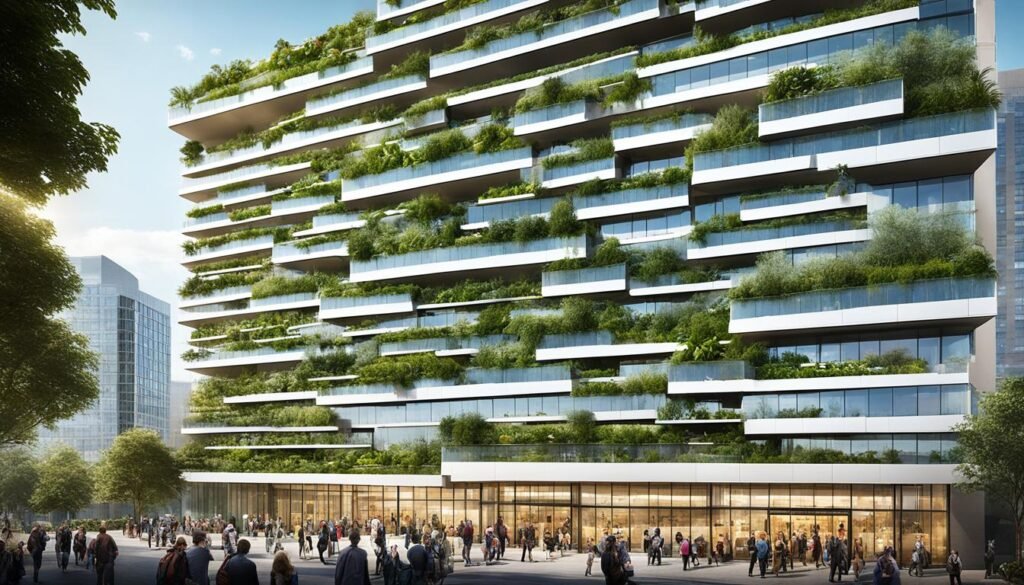
Understanding Vertical Farming
Named by Dr. Dickson Despommier in the 1990s, vertical farming grows crops in stacked layers. It uses controlled environments. Various smart farming methods, like hydroponics and aquaponics, become key here. They help save space and use resources better.
In places like AeroFarms in Newark, New Jersey, and Plenty in San Francisco, this idea is already blooming. They use high tech like AI and automation to keep crops healthy. This boosts how much food we can grow in cities.
Food Security Challenges in Urban Areas
Many city areas have little access to fresh, healthy food, known as food deserts. Vertical farming can change that. It saves a lot of water and land, which is perfect for cities tight on space. This makes farming possible in urban areas and less harmful to the planet.
With methods like hydroponics, we get healthy food minus harmful pesticides. Less pesticides mean safer food for us all. It also cuts down on food transport, making fruits and veggies fresher when they hit our plates.
Vertical farming is blending into city life, offering a new path to food safety. It brings healthy food closer to where people live. This way, city farming is making us stronger and more independent.
Environmental Benefits of Vertical Farming
Vertical farming is changing how we grow food, especially in fighting climate change. It brings major wins for the environment in city farming.
Water Conservation
Saving water is a big plus of vertical farming. It uses smart watering methods to use up to 98% less water than usual. This helps a lot since water is becoming scarce around the world.
Reduction in Carbon Emissions
It also helps reduce harmful greenhouse gases. By not needing to transport food as far, it cuts down on carbon emissions. Plus, the farms use energy much more efficiently.
Efficient Land Use
Vertical farming is really smart with space. By stacking crops, it needs much less land. This means we can grow food in cities and save countryside, making farming more climate-friendly.
The table below lists the major pluses of vertical farming:
| Benefit | Description | Impact |
|---|---|---|
| Water Conservation | Uses up to 98% less water due to advanced irrigation techniques | Significant reduction in water usage |
| Carbon Emissions Reduction | Decreases reliance on long-distance food transport | Lower greenhouse gas emissions |
| Efficient Land Use | Maximizes vertical space for crop growth | Minimizes agricultural land footprint |
| Year-Round Production | Enables continuous crop production irrespective of seasons | Stable supply of fresh, local produce |
Vertical farming is getting better all the time. With its green wins, it’s key for a future of earth-friendly farming in our cities.
Vertical Farming Food Security: A Sustainable Solution
Vertical farming is an innovative way to boost food security. It involves farming indoors under strict controls. This method lets us grow food all year, independent of the weather. It uses special water to grow healthy, top-quality crops, cutting down on using harmful pesticides.
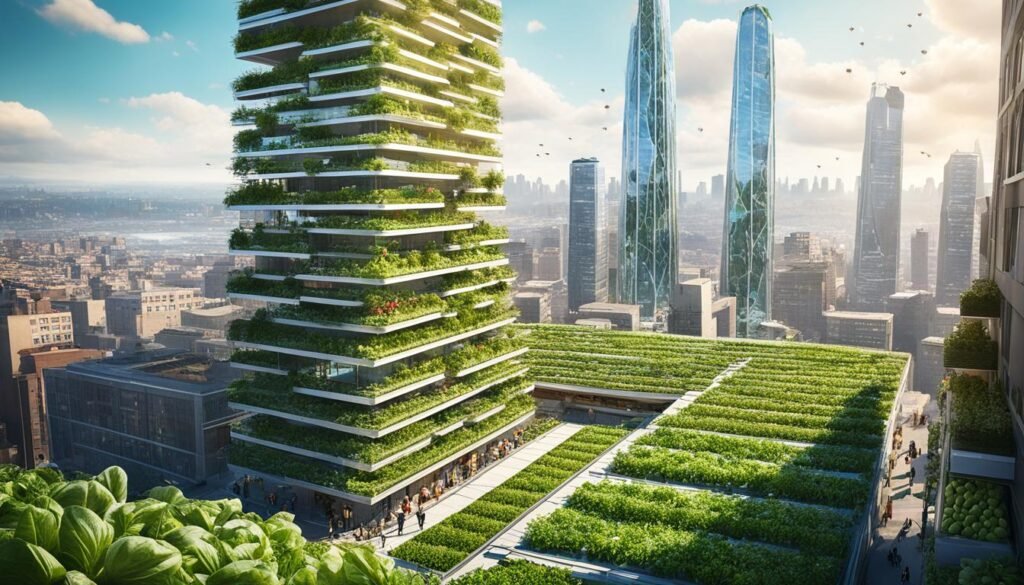
Year-Round Crop Production
Vertical farming stands out because it produces crops all the time. It uses LED lights and precise climate control to create perfect growth conditions. By doing this, fresh food is always available, helping local communities and economies.
Enhanced Nutritional Quality
This way of farming also boosts the nutrients in our food. It uses special water to feed plants exactly what they need. So, the food that’s grown is packed with essential nutrients. This step is vital, especially in cities where finding fresh food can be hard.
Minimized Pesticide Use
Another big plus of vertical farming is reducing or stopping pesticide use. The indoor, controlled setting means fewer pests, so there’s less need for harmful chemicals. This makes the food safer and helps protect the environment. It’s a win-win for both our health and the planet.
Technological Advancements in Vertical Farming
Vertical farming changes urban farming using new techniques and tech to be better for the environment and more efficient. It’s all about using hydroponic and aeroponic systems, along with advanced smart farming tech.
Hydroponic and Aeroponic Systems
In vertical farming, hydroponic and aeroponic systems are key. They deliver nutrients right to plant roots, making sure they grow well. This approach uses less water than regular farming does. It also doesn’t rely much on pesticides or fertilizers, which is good for the planet.
Smart Farming Technologies
Introducing smart farming into vertical farms has made them really efficient. Here, AI and automation work together to use resources better and grow more crops. They also bring in LED lights and robots, so crops can be grown all year. This way, vertical farming is becoming more popular and helping create a sustainable food system.
Conclusion
Vertical farming started in the 1990s, with Dr. Dickson Despommier. Since then, it has grown a lot, thanks to new technology and green practices. Now, it is a key part of growing food in cities, helping to make food production more sustainable. It uses space well by stacking crops up high, which is perfect for crowded urban areas.
This type of farming is great because it needs less land and water. It’s crucial as land and water are becoming more scarce. Vertical farms grow more food using less space and water than traditional farms. They save water by reusing nutrient-rich water, which is a lot smarter than how we usually farm. This makes them very environmentally friendly, cutting down on harmful chemicals, and greenhouse gas pollution.
Vertical farms also save a lot of energy by using efficient lights and irrigation. These farms can produce crops all year, unlike normal farms that rely on the seasons. This not only boosts the amount of food they can grow but also makes food more available, which is good for everyone in the city. Famous farms like AeroFarms in New Jersey and Plenty in San Francisco show that this type of farming can work on a big scale. But, there are still some challenges, like how to make enough profit and follow the rules.
Yet, with more smart technology and less need for people’s hands-on work, vertical farming’s future is bright. It’s a key solution to feed our growing global population, especially in cities. By the year 2050, our world could have 10 billion people. Vertical farming can help make cities more self-sufficient and strong through smart indoor farming. It’s an exciting way to grow food that fits our world’s future needs.
